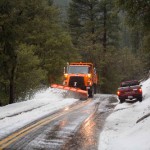California is in the midst of a three-year drought, which is no longer news. The chance of another El Niño weather pattern, however, is.
For the 2013-14 rain year, which ended on June 30, only 14.43 inches of rainfall was recorded at the Idyllwild Fire Station. This .41 inches more than the 2012-13 rain year, but only 56 percent of the long-term annual average of 25.67.
This is the third consecutive year below average and the eighth in the past 10 years. Only in 2004-05 and 2010-11 has rainfall exceeded the long-term average of 25.67 inches.
Other areas in the vicinity are just as dry. The Forest Service recorded 13.61 inches of rain at the Keenwild Ranger Station. George Tate of Pine Cove has recorded 15.54 inches of rain.
Snow is just as rare as rain. Only 5 inches of snow fell at the Idyllwild Fire Station this year compared to 42.8 inches last winter. Tate measured 13 inches of snow in Pine Cove, which was about 30 percent of the 2012-13 snow recorded.
The National Weather Service says the chance of an El Niño weather pattern forming late this summer and extending into early 2015 is between 70 and 80 percent. But not all El Niño patterns bring significant rain.
Cal Fire climatologists have predicted “fewer thunderstorms this summer compared to the past two years, especially over the Sierras southward into the mountains of Southern California.”
The Cal Fire weather report also expects “the El Niño will continue to slowly strengthen, and will possibly reach a low-end “moderate” category by the fall.” And a growing possibility of a winter “rainy season occurring in Northern California earlier than usual this year.”
As of June 10, drought designated areas now cover nearly a third of the continental United States, according to the National Weather Service. The areas (including California) affected by extreme or exceptional drought dropped to 12 percent of the contiguous states in mid-June.
“[Drought] persistence is extremely likely along the West Coast and in the Intermountain West (but especially in California) where summer and early fall is a normally dry and warm time of year, and both surface and subsoil moisture nearly always decline,” forecast the NWS last month.










